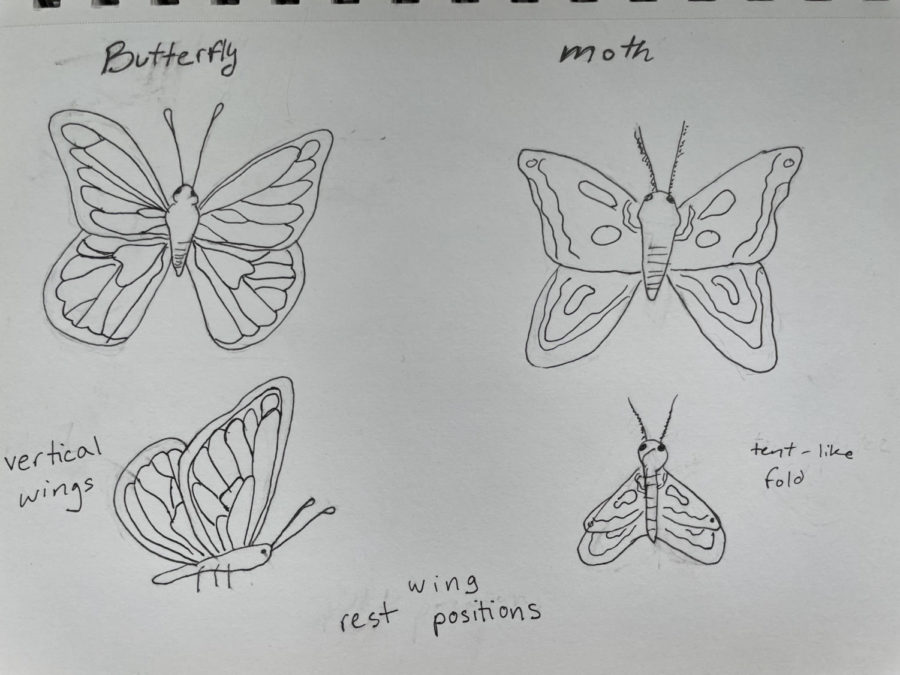What are the differences between moths and butterflies?
The Gillnetter’s Evelyn Porter has the answers you seek.
Artistic representation of a standard moth and butterfly structures
February 9, 2023
During these bitter, cold, and dreary winter months it can be easy to miss the bright summer seasons. One of the many contributions to a summer scene being fauna, one might find themselves pondering some of the big questions regarding summer wildlife.
For example, what are the distinctions between butterflies and moths?
Upon further research, such a person would discover the fact that distinctions are becoming more blurred as species are discovered and examined. However there are some general rules that can be applied when attempting to discern where the line lies between butterfly and moth.
Both butterflies and moths are species in the order lepidoptera, which is derived from the Greek words lepis (scale) and pteron (wing). A common bit of misinformation shared by both moths and butterflies is the idea that the scales on their wings are dust, and if the dust is removed the bugs will not be able to fly any more. In actuality, the dust are scales and will be regrown by the insect with no major harm to it’s life.
Despite having similar wing characteristics to a regular observer, there are some anatomical differences between the structures of the two. Moths, unlike butterflies, have a frenulum. This is a body part that attaches the forewing to the hind wing. This also changes the way that a moth folds its wings. A moth tends to hold its wings in a tent-like shape over their back, while a butterfly will keep its wings vertical.
Other physical differences include size and color, and antennae. Butterflies are typically larger and more colorful than moths. Moths tend to have colors in shades of brown, beige, white, and black. Butterflies, on the other hand, are famous for their bright vibrant patterns and colors ranging from across the rainbow. While moths and butterflies have similar sizes, the average size of a moth is smaller than the average size of a butterfly. Of course, this may change depending on which species of the two you are looking at. Moths have feathery or saw-edged antennae and butterflies have longer club shaped antennae with a bulb at the end.
Moths and butterflies both go through full mitosis, or change in physical structure. They go from egg to larva or caterpillar to pupa to adult. Pupa is the stage where mitosis occurs, and both butterflies and moths create protective structures around themselves while this stage occurs. A butterfly creates a chrysalis and a moth creates a cocoon. These two structures look very similar, and have a few differences regardless. A cocoon has a silky covering. Butterflies make chrysalis that have no silk wrapping, and are harder and smooth.
Finally, there are a few behavioral differences. Butterflies are migratory, meaning they move around depending on the season. Most moths are not migratory. However, moths are nocturnal, which means they are active at night. Most butterflies are diurnal, or active during the day, which means that when you are seeing the insect can be a big help in distinguishing between the two. Moths’ nocturnality is why they are attracted to light, as well. This is a phenomenon known as positive phototaxis. Diurnal butterflies do not experience this, and thus will not be attracted to light.
Overall, as more is discovered about both moths and butterflies the line between the two becomes more blurred. However, all of these methods, especially when combined, will be very accurate in identification. Despite these two critters having such similar appearances, structures, and lives, there are still plenty of ways to tell the two apart.











![The GHS/MERHS senior cross country runners pose together on Senior Night. [Photo courtesy of Manchester-Essex Athletics]](https://thegillnetter.com/wp-content/uploads/2025/10/Screenshot-2025-10-10-at-11.18.29-AM.png)




















Butterflylover123 • Feb 10, 2023 at 12:12 pm
I have learned much. I would give this article a 9.5628564/10 for its high quality writing and education value. I will be showing it to my descendants for future study. God save the King